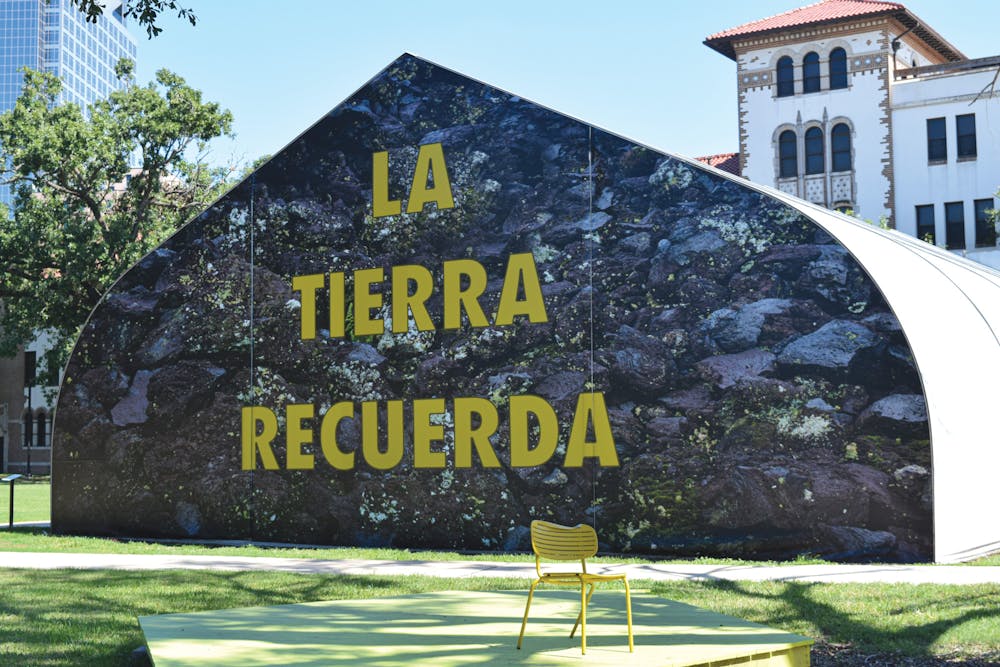Annual Tent Series spotlights identity and community

Walking past the provisional campus facilities’ tents at night, you may have noticed something different about the sides of two of them. The Moody Center for the Arts has commissioned two different works that you can see on tents one and four, one with “La Tierra Recuerda” written in big yellow letters and the other featuring a film projection of cloths and blankets, only visible when the sun is down.
Lorena Molina and Sindhu Thirumalaisamy are the two artists behind these works, which were presented in an opening reception Wednesday, Sept. 11. The works are the fifth edition of the Tent Series, an ongoing series commissioned by the Moody Center of the Arts. Alison Weaver, executive director of the Moody Center for the Arts, said this year’s Tent Series works are unique to their respective artists.
“Each iteration has featured a unique group of artists addressing diverse topics including climate change on the Gulf Coast (Sarah Welch’s Skeeter Control, 2023) to popular culture as it intersects with race, identity and community (Robert Hodge’s Everybody Loves the Sunshine, 2022)”, Weaver wrote in an email to the Thresher. “This version is unique because Lorena Molina and Sindhu Thirumalaisamy are original artists whose practice represents perspectives relevant to both their backgrounds as artists and human beings, and to the present moment.”
Molina, an assistant professor of studio art practice at San Francisco State University, who also previously taught at the University of Houston, said her work incorporates her perspective as someone who was directly displaced by the Salvadoran Civil War.
“[The] work has to do with the events that happened for my family and I to be displaced from El Salvador,” Molina said. ”I am constantly trying to understand, ‘How did this happen?’”
Molina’s work features the Spanish words “La Tierra Recuerda” in big, bold yellow letters written over an image of a group of rocks. The site of the image, El Playon, is particularly compelling for Molina because of its historical significance, she said.
“The basis for ‘La Tierra Recuerda’, which means ‘the land remembers’, has to do a lot with the historical context of the site that I’m using”, Molina said. “The site is called El Playon, which is where the last volcanic eruption happened in El Salvador, but it’s also the place where death squads during the civil war dumped bodies of civilians [and] human rights workers, so this site is really loaded with this trauma, this really painful history.”
Thirumalaisamy said she had a different approach to her tent piece and her video, “provision,” focuses on the idea of the tent as a community space. The projection features blankets and tarps being placed on the ground followed by people communicating while sitting on these fabrics.
“When I was invited to respond to that site, the first thing that I thought about was [how] that is the [Graduate] Student Bubble,” Thirumalaisamy said. “It is the space where a lot of students on campus meet to talk about things that are important to them, to organize and to debate; it’s a really, really crucial space, and I wanted to recognize that — I wanted the work to be in conversation with that.”
According to Thirumalaisamy, the title “provision” is both inspired by the name of the tent the work is situated upon and by the word’s etymology, which she believes connects to the organizing work she sees student groups do on campus.
“The tent itself is called Provisional Campus Facility, and … those tents were built during the time of COVID as testing sites and then later used as additional classrooms,” Thirumalaisamy said. “But now that it’s become a student gathering space, it’s provisioning in a different way. I went to look up the root of the word ‘provision,’ and I learned that it had to do with vision, like pro vision, meaning foresight. I thought that it was a really good word to describe the kind of visionary work I see students doing on campus, and I wanted to acknowledge that.”
Thirumalaisamy believes the works of this year’s Tent Series function well as companion pieces because of her shared interest with Molina in creating a sense of place.
“It’s great that they are happening simultaneously because I do think that they are in conversation with each other,” Thirumalaisamy said. “‘La Tierra Recuerda’, which means ‘the land remembers’ or ‘the earth remembers’, and [my] video being so much about placing these soft, temporary fabrics on to the ground and using the ground as a space to gather, I think there’s a beautiful resonance between the two.”
More from The Rice Thresher

Night Market brings Taiwanese tradition to Ray’s Courtyard
Colorful strings of paper lanterns and glowing lights hung over Ray’s Courtyard amid bustling games April 13, as the Rice Taiwanese Association hosted their annual Night Market.

Meet the Magisters: Fabiola López-Durán and Carlos Martínez-Rivera on architecture, wine and student bonds
Behind an unassuming brick exterior lies abstract art, overflowing bookshelves and handcrafted wood furniture. Floor-to-ceiling windows bathe the home of Fabiola López-Durán and Carlos Martínez-Rivera in natural light.

Media to celebrate Arab voices this month
This month is Arab American Heritage Month — so what better time to highlight media created by and about the Arab world? Here are some of the best works by Arab filmmakers, musicians and writers that showcase the diversity and complexity of Arab experiences.

Please note All comments are eligible for publication by The Rice Thresher.